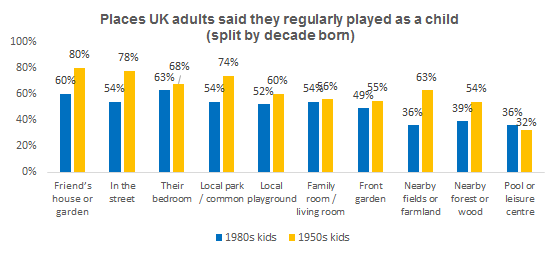Playing outdoors on the decline
Playing outdoors on the decline
In our research we found that just under half (48%) of UK adults agreed that “children don?t have enough time to be themselves nowadays”, while 59% agreed that the average child?s life today is more hectic than when they were growing up.
Almost nine in ten (88%) thought that it is important for a child?s development that they have time to play and be themselves. However, many also saw a problem with the lack of outdoor spaces to play in, with 56% believing that there aren’t enough public facilities available for children to play outside.
The changing children’s playground
When we asked Britons where they regularly played when they were a child, it revealed a clear change over the past half-century.
Those aged 25 to 34 – born in the 1980s – found that the most frequently played in place was in their own bedroom (63%) or their own back garden (62%).

However, for those born in the 1950s (aged 55 to 64), their own bedroom was fifth on the list of most common childhood play areas. 84% said they played in their back garden as a child, followed by a friend’s house/garden (80%), in the street (78%) or a local park/common (74%).
50s kids were noticeably more likely to have played in several outdoor spaces as a child than 80s kids, including nearby fields or farmland (63% vs. 36%) or nearby forest or wood (54% vs. 39%).
Opinium Research carried out an online survey of 2,006 UK adults aged 18+ from 5th to 8th August 2014. Results have been weighted to nationally representative criteria.




